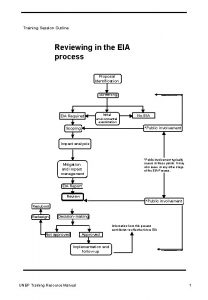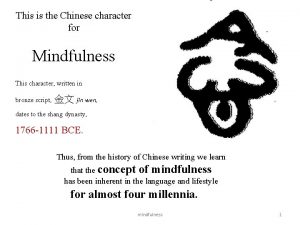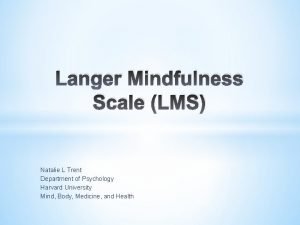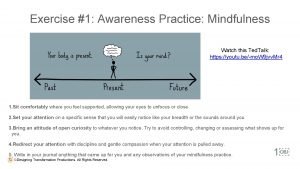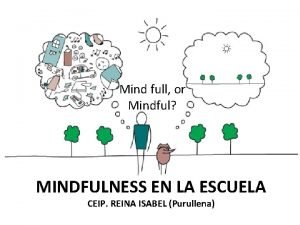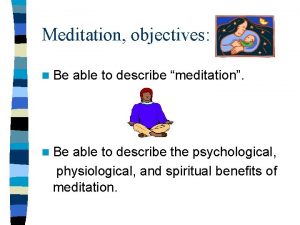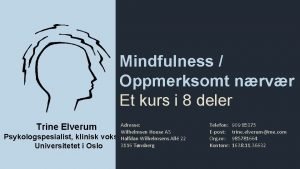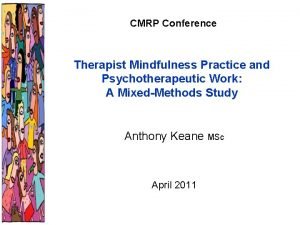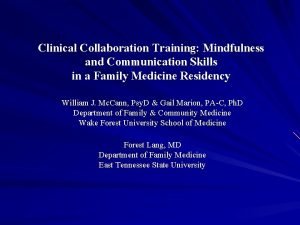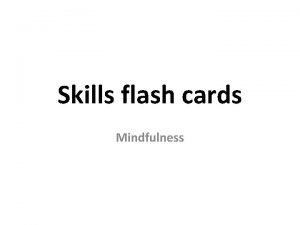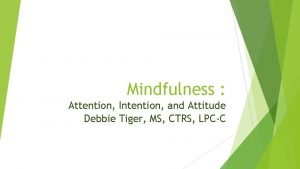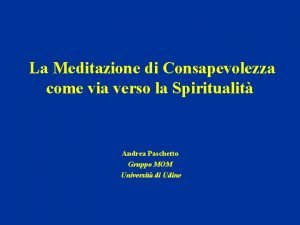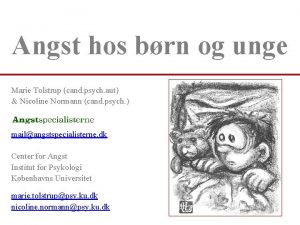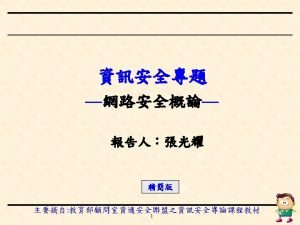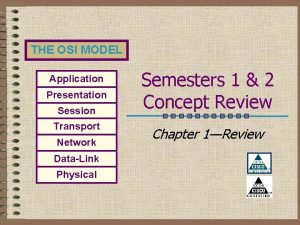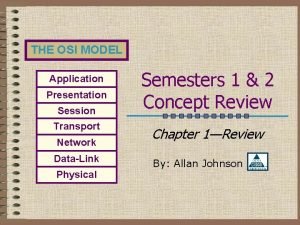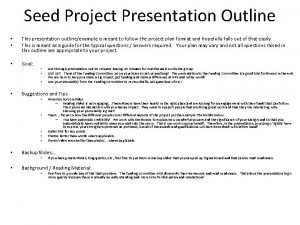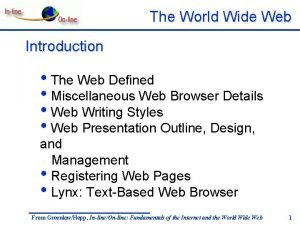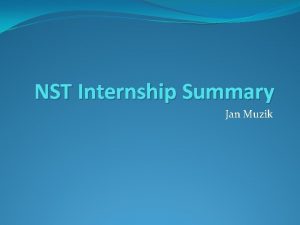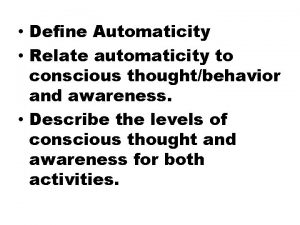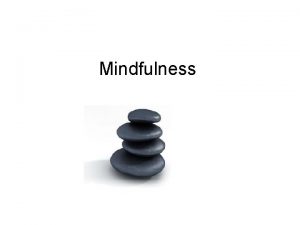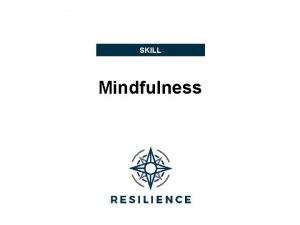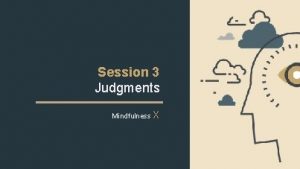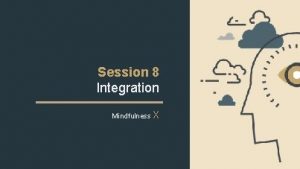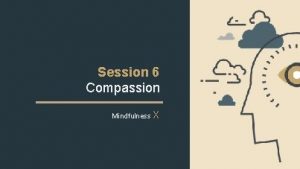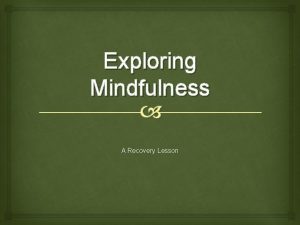Session 2 Automaticity Mindfulness X OUTLINE This Presentation






























- Slides: 30

Session 2 Automaticity Mindfulness X

OUTLINE This Presentation 1. What is Automaticity? 2. Automatic Behavior 3. Automatic Cycles

1 What is Automaticity?

1. WHAT IS AUTOMATICITY? Exercise “Imagine strolling along a street that you are wellacquainted with. As you look up, you notice that there is someone you know on the other side of the road. You smile and wave, however the person does not respond. The person continues to walk without giving you the slightest reaction. . . ”

1. WHAT IS AUTOMATICITY? Exercise § As you were imagining, did you notice any of your thoughts? § As you were imagining, did you notice any of your emotions?

1. WHAT IS AUTOMATICITY? Exercise § thoughts often emerge immediately and automatically § the mind produces stories § these stories are often not true

1. WHAT IS AUTOMATICITY? Automatism § something we do that we are not aware of § many behaviors are automatic § examples: driving, eating, playing the piano, making gestures, etc. § built through repetition

1. WHAT IS AUTOMATICITY? Benefits § fast and parallel processing possible § mental shortcuts: not necessary to examine all options all the time (e. g. making certain choices) § multitasking: little attention is needed for automatic actions

1. WHAT IS AUTOMATICITY? Disadvantages ” “We first make our habits, and then our habits make us. ” - John Dryden

1. WHAT IS AUTOMATICITY? Disadvantages § often difficult to change § unconscious, therefore not in moment

1. WHAT IS AUTOMATICITY? Disadvantages some of our automatic patterns cause problems: ü automatic desire for alcohol when in a certain place (cue) ü automatic negative thinking/rumination when unpleasant situations occur ü automatically letting emotions guide behavior

2 Automatic Behavior

2. AUTOMATIC BEHAVIOUR Reactivity SITUATION AUTOMATIC REACTION

2. AUTOMATIC BEHAVIOUR Reactivity SITUATION receiving a snide remark AUTOMATIC REACTION

2. AUTOMATIC BEHAVIOUR Reactivity SITUATION sad feeling AUTOMATIC REACTION

2. AUTOMATIC BEHAVIOUR Reactivity ” ? How can we change automatic behaviour?

2. AUTOMATIC BEHAVIOUR Reactivity ” ! by increasing attention

2. AUTOMATIC BEHAVIOUR Mindful Attention SITUATION MINDFUL ATTENTION REACTION

2. AUTOMATIC BEHAVIOUR Mindful Attention SITUATION MINDFUL ATTENTION What is going on? What do I feel? What am I about to do? REACTION

2. AUTOMATIC BEHAVIOUR Mindful Attention SITUATION receiving a snide remark MINDFUL ATTENTION I am getting angry I feel tension in my chest I want to hurt the other person REACTION shouting? staying calm? walking away?

2. AUTOMATIC BEHAVIOUR Mindful Attention SITUATION receiving a snide remark MINDFUL ATTENTION I am getting angry I feel tension in my chest I want to hurt the other person REACTION CONSCIOUS CHOICE

3 Automatic Cycles

3. AUTOMATIC CYCLES Cycles of feeling and thinking EMOTIONS THOUGHTS

3. AUTOMATIC CYCLES Cycles of feeling and thinking EMOTIONS SITUATION THOUGHTS

3. AUTOMATIC CYCLES Cycles of feeling and thinking FRUSTRATION TRAFFIC JAM “I HATE THIS”

3. AUTOMATIC CYCLES Cycles of feeling and thinking “I DON’T WANT TO FEEL THIS WAY” BAD EVALUATION FRUSTRATION “WHY DID I NOT WORK HARDER? ” GUILT

3. AUTOMATIC CYCLES Cycles of feeling and thinking § captured in cycle § attempting to not feel or think about it: more captured than before § cycle determines our feelings

3. AUTOMATIC CYCLES Leaving the cycle 1. connect to the present moment (anchor) 2. allow feelings to be present 3. notice when thinking takes over again 4. return to anchor

3. AUTOMATIC CYCLES Cycles of feeling and thinking EMOTIONS mindful awareness SITUATION THOUGHTS

Thanks For your attention
 Training session outline
Training session outline Chinese symbol for mindfulness
Chinese symbol for mindfulness Brainpop precision and accuracy quiz answers
Brainpop precision and accuracy quiz answers Mindfulness gyerekeknek
Mindfulness gyerekeknek Langer mindfulness scale
Langer mindfulness scale Ted talk mindfulness
Ted talk mindfulness Mindfulness or mind full
Mindfulness or mind full Describe meditation
Describe meditation Ga toch weg met je mindfulness
Ga toch weg met je mindfulness Mindfulness definisjon
Mindfulness definisjon Mindfulness
Mindfulness Mindfulness for collaboration
Mindfulness for collaboration Mindfulness circle
Mindfulness circle Physical sensations examples
Physical sensations examples Dhamma
Dhamma Intention attention attitude
Intention attention attitude Cristiano crescentini
Cristiano crescentini Detached mindfulness øvelser
Detached mindfulness øvelser Application presentation session transport network
Application presentation session transport network Number of bits borrowed
Number of bits borrowed Application presentation session transport network
Application presentation session transport network Quotation sandwich examples
Quotation sandwich examples Usbank developer portal
Usbank developer portal Presentation outline slide
Presentation outline slide Project presentation outline
Project presentation outline Outline of presentation
Outline of presentation Pictures of world wide web
Pictures of world wide web Internship summary presentation
Internship summary presentation Seminar presentation outline
Seminar presentation outline Training presentation outline
Training presentation outline Sales presentation outline
Sales presentation outline
